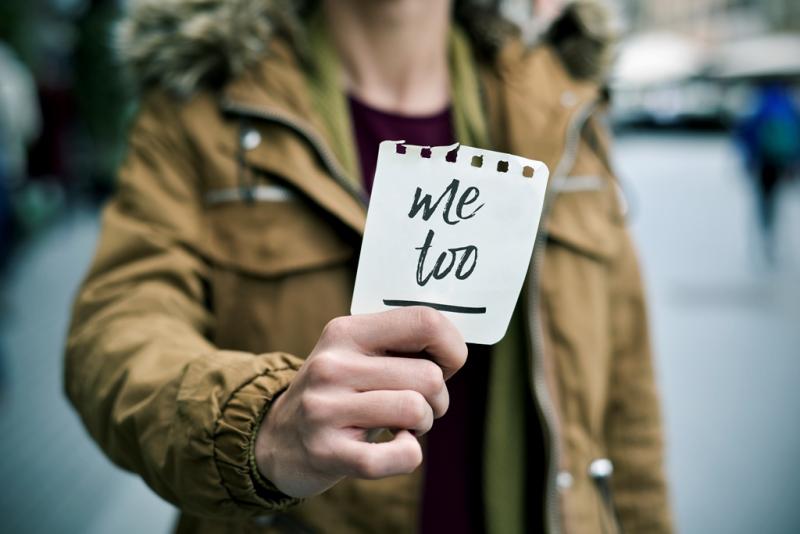The journalist and researcher Thea Storøy Elnan wrote the chapter “How the #MeToo 2.0 Campaign Changed the Way Norwegian Journalists Write About Rape” in the book Reporting on Sexual Violence in the #MeToo era, published in 2022. Elnan covered several #MeToo cases for the newspaper Aftenposten before becoming a Journalist Fellow at the Reuters Institute in 2019.
“The MeToo movement, which reached its peak in Norway at the end of 2017, raised awareness about the prevalence of sexual harassment and sexual violence,” Elnan says.

“The number of cases that came to light during the MeToo movement made a strong impression on me as a journalist and I wanted to find out if it had made an impact on other journalists too.”
Myths about rape in the Norwegian media
“I began by looking at so-called rape myths. They are the myths that the media tends to convey about rape when they fail to give a full and truthful picture of what sexual violence is,” she says.
Elnan explains that there are three main features in the coverage of sexual violence in the media that perpetuate rape myths in Norway.
“The first myth is that of victim blaming – that is, blaming rape victims because of how they were dressed, their sexuality, or because they were intoxicated. The second myth is that people who have been raped are lying because they regret having sex and want to distance themselves from the act. The last myth is the representation of the perpetrator as sick, strange, or as a monster and fundamentally different from the rest of us,” she says.
“This last myth is perpetuated by the fact that journalists are more likely to reference the ethnical background of the perpetrator if they are of foreign descent as opposed to ethnically Norwegian.”
This gives the impression that sexual violence is something exceptional, and that perpetrators are social outcasts, Elnan explains. This is inconsistent with the statistical data on rape, which show that rape is widespread, and that the perpetrator is usually someone the victim knows personally.
“I wanted to find out whether the MeToo movement resulted in fewer rape myths in the Norwegian media.”
Throughout the world, the media has a way of simplifying and trivialising sexual harassment and sexual violence, which leads to the perpetuation of rape myths in society. The term comes from the “Rape Myth Acceptance Scale”, developed by Diana Payne, Kimberly Lonsway and Louise Fitzgerald in 1999. The media's perpetuation of rape myths can be divided into four main categories:
- Journalists tend to sensationalise rape and describe sexual violence as something exceptional that rarely occurs, even though sexual violence is relatively common.
- The media tends to focus on sexual violence and sexual harassment by male leaders in positions of power, as opposed to sexual harassment in more equal relationships between, for example, colleagues. This contributes to the idea that violence is exceptional.
- Sexual harassment is portrayed as something for which both the perpetrator and the victim are responsible. This reinforces the notion that one “deserves” to be subjected to sexual violence and leads to victim blaming – the notion that the rape victim is responsible for what the perpetrator has done.
- When a news story is based on the victim's explanation of the events, the perpetrator is portrayed as a “monster” and a societal outcast. This is more often mentioned if the perpetrator is of foreign descent, even though the perpetrator tends to be a friend, acquaintance or boyfriend of the victim.
Source: Elnan 2022
Media refers to research more often
Elnan carried out a quantitative content analysis of news stories that contained the word voldtekt (“rape”) that were published in Norway between October 2017 and March 2018. This produced a sample of 400 articles, which she then analysed to determine whether they reproduced rape myths, and if so, which ones.
“The most common rape myth is that of the person accused being described as a foreigner or an outsider,” she says.
“Overall, there is a slight decline in the circulation of rape myths after the MeToo movement. In the articles published before the MeToo movement, 44 per cent contained rape myths. In the articles published at a later date, this figure was 39 per cent."
To explain this improvement, Elnan points out that journalists who report on rape have become better at referring to research and statistics.
“They also draw more comparisons with other cases of sexual violence,” she elaborates.
"As a result, sexual violence is more portrayed as a structural problem, rather than an isolated incident."
One unexpected finding was that, after the MeToo movement, it became less common to include secondary sources that corroborated the victim's description of events.
“It's difficult to say why this is the case. One possible reason is that the person who has been subjected to rape has more legitimacy, meaning that their description of events doesn’t need corroborating,” she says.
#MeToo was also about the ethics of journalism
“As well as dealing with sexual violations and power relations in the workplace, the MeToo movement was about the ethics of journalism,” says Anja Sletteland.

Sletteland is an associate professor of social sciences at OsloMet. She has published two books about sexual harassment, one of them about the media's coverage of the Giske affair.
“The MeToo movement affects how we cover difficult issues and how we portray both the victim and the accused,” she says.
“In the beginning, MeToo was largely covered by cultural journalists, because the movement had its roots in the cultural sector,” she says.
“Once accusations of sexual harassment were made against politicians, more political journalists began to report on MeToo. As a result, the media coverage became more sensationalist."
This presents an ethical dilemma, Sletteland explains. On the one hand, covering sexual harassment is a way of criticising the system: It involves investigate different sectors in order to uncover whistleblowing systems and be aware of the context in which violations occur.
“But when covering political MeToo stories – such as the Giske affair – a question is also raised as to whether politicians deserve our trust. The focus can shift to a power struggle, which makes the coverage more sensationalised. As a result, the victim is often decentred from the narrative,” she says.
Even though MeToo cases in politics often become sensationalised scandals, it still provides activists with a useful avenue to challenge the system, Sletteland says.
“Not all structural criticism disappears with sensationalism. However, the perspective on the system is narrowed down to political parties and the way they handle such matters,” she says.
Sletteland also points out that journalists’ responsibility to uncover MeToo cases can come into conflict with the principle that the accused is innocent until proven guilty.
“This has always been a dilemma. At the same, MeToo movement did trigger a debate on the ethics of journalism,” she said.
Still room for improvement
Journalism about sexual assault and harassment still has room for improvement, Elnan says.
“There are still rape myths in the Norwegian media, and there is still a problem with sexual harassment in the workplace,” she says.
MeToo was largely centred on the experiences of privileged white women. As a result, the debate on sexual harassment was limited to their perspectives, Sletteland says.
“The intersectional perspective was missing from Norwegian discussions of MeToo. We also failed to talk about men as victims of violations and abuse.”
“But while there is still room for improvement, I believe the MeToo movement brought lasting change both to society and the media,” she concludes.



